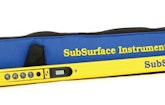
Interested in Location/Detection?
Get Location/Detection articles, news and videos right in your inbox! Sign up now.
Location/Detection + Get AlertsAccurate locating of underground utilities is critical for municipal and utility work crews. Failure to pinpoint buried lines can carry heavy costs from the extra time and expense of having to relocate, to the cost of repairing utilities damaged by digging in the wrong place.
Magnetic locators are a common tool in field crews’ kits. These relatively simple instruments have one primary purpose — to detect ferrous metal. The ML-3 magnetic locators from SubSurface Instruments are designed to simplify locating and to withstand challenging conditions in the field.
Scott Rauen, SubSurface Instruments sales manager, demonstrated both the short and long versions of the ML-3 on a 20-degree F December day in Ladysmith, Wis. The snow cover had no impact on the unit, which accurately detected water shutoff valves along a quiet residential street.
Walk-around
The ML-3 looks different from most magnetic locators in that the typical electronics and display box is absent. All components in the ML-3 are inside the cylindrical aircraft-grade aluminum body, about the same diameter as an empty paper towel roll.
The 40-inch ML-3S weighs 1.8 pounds, and the 55-inch ML-3L weighs 2.8 pounds. The impetus for the locator’s design came from the U.S. military, for which low weight and durability are key factors. The extra length of the ML-3L allows military users to make wider sweeps when searching for improvised explosive devices and unexploded ordnance.
Most users won’t notice a difference in the performance of the long and short versions, according to Rauen.
“A majority of what any utility or any surveyor is usually looking for is in the top three feet,” he said. In fact, he noted, most of what they look for is probably within two feet of the surface.
The controls on the ML-3 are simple and intuitive. A small keypad just below the rubberized handle includes controls for Power, Gain Up and Gain Down, and a Zero button used to adjust the unit for magnetic anomalies such as a magnetic gradient in the soil. The speaker is positioned between the keypad and the LCD display.
Each push of the Gain buttons changes the unit’s sensitivity up or down one increment at a time, with eight possible settings. A microprocessor remembers the Gain setting when the device is turned off and returns to that setting when it is powered back on.
The small LCD display fills with bars indicating the strength of the detected signal and indicates polarity with a “+” or “-” sign at the top. The display also provides a low-battery indicator. While the display does not show the gain setting, it is simple to turn the gain all the way down and start over from there if it’s necessary to determine the exact setting.
The units run on three standard 9-volt batteries with a life of about 60 hours. The sensors, which are digitally tuned for optimum accuracy and consistency, operate at 16.5 kHz and can perform in temperatures from 140 to -13 degrees F.
The bright-yellow locator comes with a seven-year warranty and includes a soft case with carrying straps and a pocket for the manual and extra batteries. An aluminum hard case is also available.
Operation
Using the ML-3 is much like using any other magnetic locator. The operator walks slowly, sweeping the locator back and forth. Audio signals indicate the presence of ferrous metal and get stronger as the locator gets closer to the target.
Rauen started by powering the unit on. He zeroed it in and turned the gain all the way down to get to a known starting point. From there, he turned the gain back up several notches and started scanning along the sidewalk and street edge for a shutoff valve near a fire hydrant.
The locator’s indicating signal quickly became audible as it detected ferrous metal. Rauen slowed down at that point. With the target roughly located, he turned the gain back down and made slow and careful sweeps with the wand, paying close attention to the signal, which grew louder as he homed in and pinpointed the valve.
From there, the demonstration moved out into the street, where a fresh layer of snow and ice concealed the locations of additional shutoffs. Rauen made slow passes with the locator around a bend in the road. As the audible signal gained strength, he again slowed and made very deliberate sweeps with the wand until he had an approximate location of the target.
With the target location narrowed considerably, Rauen demonstrated the unit’s pinpoint locating capabilities. First, he lowered the gain setting to the lowest level that could still detect the target. Then, he raised his hand and loosened his grip, allowing the unit to swing down from its normal sweeping position.
With the locator perpendicular to the ground, he moved it back and forth in an X pattern over the target, shifting its position until the peak signal response came from the center of the X, where the shutoff sat beneath the snow.
The ice-covered edges of the nearby Flambeau River prevented a demonstration of the ML-3’s underwater capabilities, but Rauen explained that the unit has been extensively and successfully tested under water.
“You can hear it very clearly under water, so you could snorkel with it and there’s no question that you can tell when you come across something that’s metallic under water,” Rauen said, noting that a diver took the ML-3 down more than 200 feet in Lake Michigan, where tests of the instrument were 100 percent successful.
At the end of the demonstration, Rauen tested the locator’s durability. He left it lying in the street, returned to his vehicle, and drove over the unit lengthwise. He approached it again from the side, only to have his wet tires push it ahead, and then drove over it lengthwise one more time. After the demonstration, the unit turned on again without hesitation and functioned normally.
Observer comments
The ML-3 is simple to operate, with straightforward, intuitive controls. Even for someone inexperienced with magnetic locating, it was easy to operate and zero in on targets. The slim and lightweight device seemed comfortable to operate for extended periods, and its responsiveness made it easy for a novice to home in on hidden shutoff valves.
It would be convenient to have the gain setting visible on the display, although it was simple enough to turn it all the way down and readjust from that point.
Manufacturer comments
“We wanted a unit that was going to be as durable as possible, and by coming up with this design, we were able to waterproof it as well,” Rauen said. “That eliminates one of the major problems anyone could have with a magnetic locator, which is getting water into the electronics.”
The digitally tuned sensors add sensitivity and consistency, Rauen added. Digital tuning ensures that both sensors are tuned identically and are the same from one unit to the next, so that operators can expect consistent results.
“This unit will find objects, depending on their size, up to 12 feet deep,” Rauen said.








